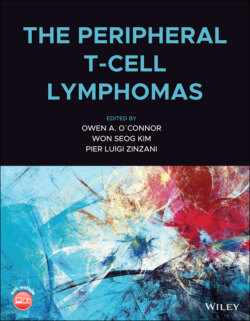Читать книгу The Peripheral T-Cell Lymphomas - Группа авторов - Страница 56
Hepatosplenic T‐cell Lymphomas
ОглавлениеThis rare entity is derived from gamma/delta T‐cells which occurs more commonly in young men with a median age of around 35 years [76]. The malignant cells may be negative for both CD4 and CD8, and may infiltrate the liver, spleen, and bone marrow in a marked sinusoidal pattern. Recurrent isochromosome 7q and trisomy 8 has also been noted on cytogenetic studies, while. STAT5B is mutated in up to 31% of cases, STAT3 in 9% and PI3KCD in 9% [78]. Interestingly, gene‐expression profiling studies have confirmed that tends to cluster close to the extranodal natural‐killer (NK)/TCL (ENKTCL) with overexpression of NK markers like KIR and killer lectin‐like receptors, CD16, CD56, and NKG2F especially in the T γδ as opposed to αβ subtypes [60].
Dysregulation of various epigenetic pathways, some seen in other subtypes, others of which appear more commonly in HSTCL. For example, comprehensive genomic studies of HSTCL have identified chromatic modifying gene mutations in a variety of genes including SETD2 and ARID1B in up to 62% of cases. The ARID1B gene (AT‐rich interactive domain‐containing protein 1B) encodes for a protein that binds to DNA helping to target SWI/SNF complexes which regulate gene expression by modulating chomatin remodeling. Somatic mutations in ARID1B are associated with many malignancies, consistent with its functions as a tumor suppressor gene [79–82].
